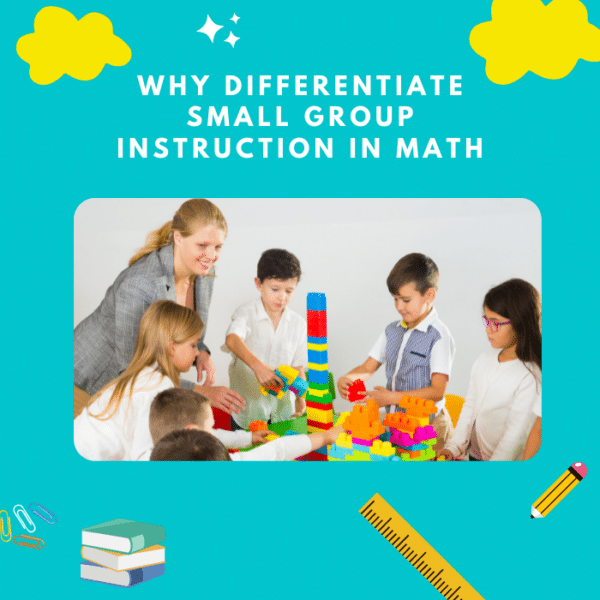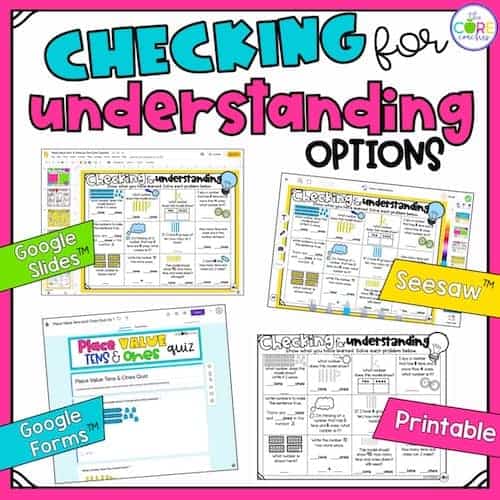Why differentiate small group instruction in math?
As elementary teachers, we are responsible for helping students learn about multiple subjects to students who learn very differently than one another. So, how do we teach students differently, across multiple subjects, and make sure they all learn what they need to? Differentiation!
You have probably already heard of differentiation. Differentiation is a popular instructional strategy because it is so effective! If you are not familiar with differentiation, it is the process of modifying instruction to meet individual student needs. When you first begin to explore differentiation it can feel overwhelming – how do you meet the needs of EVERY single student?!
This is a very common reaction! While differentiation does take some planning, it doesn’t need to be as overwhelming as it initially seems. One of our favorite ways to differentiate instruction is through small group instruction. Small group instruction helps teachers meet the needs of all students in a manageable way.
Small group instruction is commonly used for reading in elementary classrooms. Did you know that it can also be used for teaching math?! Yup! There’s a lot of discussion in the education world around why using small groups for reading is beneficial… but let’s consider differentiated small group instruction in math.
Using small groups for math instruction offers the same benefits as using small groups for reading. Small groups allow for teachers to address the different needs of each student. In a similar way to how we group students for reading based on lexile levels, etc., we can group students for math by levels as well. This means teachers are able to provide a focused lesson based on the skills that a particular group of students needs.
Beyond the ability to focus instruction for a particular group, there are other advantages to small groups for math instruction.
Small group instruction allows for more students to ask questions. In a whole class setting, it is difficult for every single student to ask the questions they need; it is also difficult for the teacher to adequately answer every question a student may have. In small groups though, there are more opportunities for questions to be asked and not just quickly answered, but demonstrated.
Demonstration is an essential part of teaching math. The teacher can demonstrate a concept when teaching the whole class, but it’s difficult to see which students are engaging with that demonstration; moreover, which ones are truly understanding the concept.
In small groups, you can see every student engaging with the demonstration of a skill. You can also immediately see them practice that same skill. This immediate demonstration of understanding allows you as the teacher to quickly assess a student’s understanding.
Beyond allowing teachers to work one on one with more students, small groups also allow for students to learn from each other. These opportunities for collaboration are equally important to student learning. Have you ever heard that we learn a concept better when we teach it to someone else? It is true! Being able to teach a concept requires you to KNOW a concept well! So, when students work through math problems together, they are essentially teaching each other what they know, while also learning from one another. This is a great way to strengthen students’ knowledge and understanding of math concepts.
Trying to differentiate instruction often feels overwhelming for teachers because they think it means we need a different approach or a different assignment for every single student!
We don’t!
Not only is that not feasible, it is not necessarily the best. Just as we pointed out above, collaboration is one of the best ways for students to learn. Whether students are working in a small group with you or in small groups together, they are getting the benefits of differentiated instruction – in the BEST way!
Now that you know why differentiating math instruction in groups can be beneficial, check out our easy to implement digital and printable math activities to see how you can make this happen in your classroom!
HOW TO DO SMALL GROUP MATH INSTRUCTION IN 1ST GRADE
One of the most important things when beginning to implement differentiated instruction in your classroom is to make it doable! The idea of trying to differentiate can often feel difficult or overwhelming, but it doesn’t have to be either of those things! The one thing it does take, initially, is just a little bit of planning. Once you have made a plan though, small group work can actually help save you time.

Below, we’ve outlined our favorite way to begin using small groups for math. Follow these steps to help you get ideas on how to do small group math instruction in 1st grade! Or click here to download our digital math activities that are perfect for small group instruction.
Begin by assigning your whole class the same math activity. Before you can differentiate instruction, you need to know what differentiated instruction you need! That means you need a starting point. This is where whole group instruction is important and necessary.
Start with a whole group lesson on a new math skill. After direct instruction, assign students an independent practice assignment. While they are working, walk around the room and check their work. This is a way to quickly assess how well students are understanding the concept.
While you are assessing the students’ work, keep a notepad or clipboard with you and begin to group students while you walk around the room. This will save you time when you finalize your groups later.
If you want to further assess student work before making groups, collect the practice assignment. Don’t grade the entire assignment! Yes, you heard us correctly. You are not grading this assignment, it’s practice. Simply choose 3-5 questions (depending on the length of the assignment) that you feel will help you determine each student’s understanding of a concept. Then, quickly score those few questions. Using that data, create groups.
TIP:
If you are new to using differentiated groups, we suggest assigning groups based on similar ability or level of understanding. Later on, there is room for assigning groups that contain students on different levels, but the majority of the time, we suggest doing similar leveled groups. One way to accomplish this is to group kids based on their level of understanding for each math concept. Click here to learn more about digital and printable checking for understanding options.

The process from the time you introduce a new concept during whole group instruction, until meeting in small groups, will take a few lessons. To make this process easier over time, we suggest making it a part of each unit. At the beginning of every unit, spend the first one or two lessons doing whole group instruction, then use the data to create small groups for the rest of the unit. This process will become more familiar and easier over the course of the year – you’ll be an expert before the year is through!
Once groups have been created, there are a couple of different ways you can use them.
One way is to have the entire class working in small groups at the same time. Choose one assignment you want the whole class to use, but modify it for each group. An easy way to do this is to simply tell each group what numbers they will work on. You can also provide different assignments if needed. One way to make this easy, is to use a resource that provides several different assignments that cover one skill, then choose which assignment is best suited for each group. Here are some examples of resources that have multiple assignments to choose from:
If you have a group that is struggling with the basic concepts, give them practice questions that help to clarify the concept. Then provide them with additional practice for mastery. Leave out anything too complex until they’ve mastered the basics. For another group that has already mastered the basics, provide a set of more challenging questions to work through together.
Create as many groups as needed. If you have several students that need to work on the same skills, you can create multiple groups that are all working on the same skill. Try not to have more than 4-5 students per group. To help students take ownership of their learning, assign activities that have both practice and assessment pieces. Then, provide answer keys that students can use to check their work. Having students check their own work not only helps them see their own learning, it also helps you with grading: quickly scan the ones marked incorrect and make a plan from there (rather than grading the whole assignment).
Another way to use groups is to allow students to work in their small groups as outlined above, but then choose one or two groups to work with you during this time. This is a great way for struggling students to receive additional support. You can simply move from group to group, spending as much time as needed with each one. It’s okay if you don’t get to every group! Simply start with a new group the next day.
A third way we like to use groups is to combine them with independent practice. Still using the data you gathered about what skills each student needs to work on, assign appropriate independent practice: the specific number of problems on a worksheet or different activities. Just as with groups, provide students with practice work, an assessment, and an answer sheet. While students work independently, call small groups back to a table to work with you.
Working with small groups in this way gives you time to work with not only struggling students, but students at all levels! During these small groups, you not only get to offer support, but also gain opportunities to reassess students for future groups.
Whether using small groups throughout the whole class, or a combination of small groups and independent learning, digital math activities are a great way to keep students engaged. If you are ready to begin using small group differentiated instruction for math, check out some of our favorite resources to help you get started, and save you time with planning!





